|
|
|
|
Brown Line: Ravenswood branch
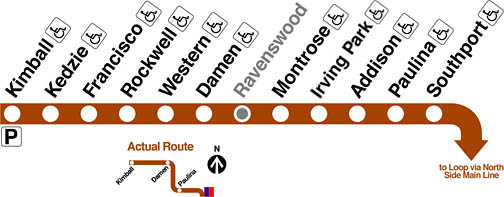 |
||||||||||
|
Legend:
Click on a station name to see that station's profile (where available) |
|
|
|
|
Brown Line: Ravenswood branch
 |
||||||||||
|
Legend:
Click on a station name to see that station's profile (where available) |
Service Notes:
History:
After its main line was in operation, the Northwestern Elevated Railroad turned its attention to building one of the extensions allowed for in its franchise from the city. The company chose to exercise the option to build a branch to Ravenswood, which around the turn of the century was a sparsely-populated area of the city largely occupied by farms and small homesteads. However, real estate developers were already eying the area to build apartments and homes and many of these developers saw fast rapid transit access to downtown as an essential part of a successful project.
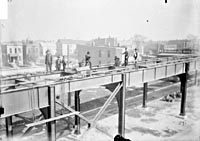 The Ravenswood branch's elevated structure is under construction in this 1906 view showing seven workmen on top of the structure. This section is near Newport and Racine Avenues. For a larger view, click here [off-site link]. (Image #DN-0004189, Chicago Daily News negatives collection, Chicago Historical Society Collection) |
The first proposal the Northwestern submitted to the city in 1903 had the Ravenswood branch leave the main line just west of Sheridan station, continuing west along Irving Park Road to the vicinity of the Chicago & North Western Railroad (no relation) and Ravenswood Avenue, where it would turn north and parallel this alignment past Montrose Avenue, then turn west again and terminate at Western Avenue. Considering the Northwestern's rather poor history with the city council concerning franchises, the council's Committee on Local Transportation took its time reviewing the proposal.
A year later, the committee responded with a number of changes to the proposal, including a revision to have the extension branch off the main line at Clark and Roscoe, following Newport Avenue west to the Chicago & North Western, then turning north and continuing on the previously-proposed alignment north to Leland Avenue, then west to Western Avenue. The aldermen added several other details to the franchise unrelated to the extension as well -- including stations at Oak and Willow on the main line, half fares for children, and universal transfers on all elevated companies' lines -- which threatened the entire project when the company strenuously objected. Mayor Harrison vetoed the franchise and returned it to the city council with most of the related requirements deleted and the council approved it in January 1905.
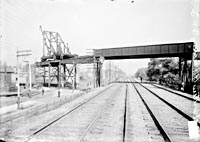 To cross the elevated embankment of the Chicago & North Western, the Ravenswood branch had to rise to an exceptionally high level. The bridge and crossing are under construction, looking north in 1906 as workmen stand on Ravenswood Avenue on the left. For a larger view, click here [off-site link]. (Image #DN-0004126, Chicago Daily News negatives collection, Chicago Historical Society Collection) |
Service on the Ravenswood branch to Western Avenue was inaugurated on May 18, 1907. The stations on this elevated portion were all generally the same, with only very small variations in design and layout, usually only caused by site requirements. The headhouses were of a modest size and scale, relating to their role as a modest neighborhood stations. The buildings' exteriors were constructed of dark brick and had a fairly simple design. The walls are largely unadorned, except for simple ornamentation around the cornice, belt rail, and in the hood over the front entrance, all of which is executed in the same brick as the rest of the exterior. The interiors of the stations were similarly modest. The interior walls were clad in glazed brick and a large, bracketed, heavy wood beam ran across width of the interior in the center, relating a Craftsman-influence to the simple designs. At platform level, the canopies had a gently curved roof with latticed support columns and framing. This design was first used throughout the Ravenswood branch, but became a standard design for the Northwestern (and later the CER) and was used at a number of stations systemwide in the 1910s and 1920s. The original platform railings consisted of flat panels alternated with thin balustrades and sunflower rosettes. A center storage track at Western provided for some car storage until the line to Kimball was completed, where a yard would be built. When the branch opened, the terminal was still surrounded by farms, but within two months the branch was handling 10,000 riders a day.
The rest of the branch to Kimball & Lawrence was put into service on December 14, 1907. The four stations on this section were not all identical in design, but had a similar low-slung scale, which fit well with their locations. The first two stations, Rockwell and Francisco, were situated in residential communities of modest density and drew largely on walk-in traffic from the neat rows of brick bungalows and frame houses. Thus, these stations were small wood frame structures set in the center of the tracks. The buildings had peaked roofs and clapboard exteriors, but little in terms of ornamentation or embellishment. The back door led to the island platform. The canopy, a flat wooden affair supported by square wooden posts and angled brackets, stretched only just under two car lengths. The last two stations, Kedzie and Kimball terminal, had larger stations with more substantial headhouses, each of a unique design. Kedzie's was a narrow but substantial building set between the tracks. The station, designed by architect Arthur U. Gerber, featured several Craftsman characteristics, including a bracketed hipped roof similar to other bungaloid structures Gerber designed elsewhere on the "L". Kimball station was also designed by architect Gerber in a bungalow form using Craftsman influences and elements. But whereas Kedzie was a thin and taller building, Kimball featured massive, low-pitched, half-timbered gables. Originally, the Kimball had a single island platform, served on the west by a stub track and on the east by another track that looped back to allow easy dispatching without changing ends. Later, this loop was removed and shortened to another stub serving the island platform. A third lay-up track and a side platform were later added to the east of the other two station tracks.
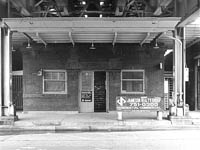 A southbound 4-car Ravenswood-Englewood-Normal Park train of 4000-series "Baldies" slows to stop at Irving Park on the Ravenswood branch in the 1940s. For a larger view, click here. (Photo from the Chicago Transit Authority Collection) |
After "L" operations were consolidated under the Chicago Elevated Railway Collateral Trust (CER) in 1911, attention was quickly turned to the through-routing of trains. On July 21, 1913, the through-routing ordinance was passed and crosstown service began November 3, 1913. From this date, Ravenswood branch service was through-routed with the Kenwood branch on the South Side, operating via the North Side Main Line, Loop Elevated, and South Side Main Line. Since Ravenswood traffic was a little heavier than Kenwood traffic, some Ravenswood trains were turned back in the Loop. Early on, there were also a few Ravenswood trips that terminated at 61st Street instead of Kenwood, but these were discontinued within a short period.
Crosstown service was revamped several times in the years that followed. On February 23, 1931, the Chicago Rapid Transit (CRT), who'd taken over operations from the CER, made a few changes to crosstown service. The Wilson-Englewood and Ravenswood-Kenwood through-routes were swopped. To better adjust to the traffic patterns, the Ravenswood-Englewood/Normal Park through-route was only in effect in rush hour; at all other times, Ravenswood trains terminated in the Loop. With the opening of the State Street Subway on October 17, 1943 the Loop's severe congestion could finally be relieved. Englewood/Normal Park-Ravenswood trains were rerouted to the new subway. Englewood and Ravenswood trains were through-routed at all times from then on, discontinuing the off-peak Ravenswood-Loop runs... For the time being...
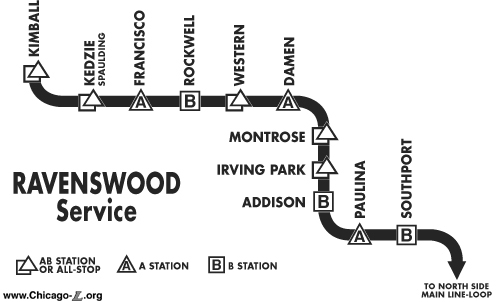 |
|
Ravenswood service on the branch as it appeared circa 1960. The service pattern dated from the North-South reorganization of 1949. In 1973, Addison changed to an "A" station and Irving Park became an "AB" station. Otherwise, the pattern remained unchanged until skip-stop service was abandoned in 1995. (Graphic by Graham Garfield, based on CTA maps of the period) |
.
Developments in the CTA Era
The Ravenswood service as we know it today (now under the name "Brown Line") was formed after the Chicago Transit Authority took over operation of the rapid transit system in 1947, when the CTA began making a series of changes in quick succession.
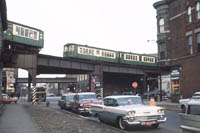 Two Ravenswood trains -- an "A" train heading toward downtown on the left and a "B" train heading to Kimball on the right -- pass each other at Roscoe, just north of where the Ravenswood branch leaves the main line, in 1963. Center-door 4000s like these provided most of the service on the branch at this time. For a larger view, click here. (Photo by Jim Northcutt, from the Illinois Railway Museum Collection, courtesy of Peter Vesic) |
The skip-stop system was tested with great success first on the Lake Street Line in 1948, and the North-South operations were chosen as the next section to be improved. In early 1949, service from the Ravenswood branch consisted largely of Ravenswood-Englewood/Normal Park express trains that operated via subway. In addition, there were a few Ravenswood-Loop express trips in the Monday-Friday morning rush hours and a few northbound North Water Terminal-Ravenswood trips in the Monday-Friday evening rush. These routings, combined with the other litany of diverse North-South services, were thus highly complex and any change to the schedule would cascade through the system and cause numerous problems. As such, it was decided to greatly streamline the crosstown services into just three simple routes.
Effective August 1, 1949, the Ravenswood Line, as it is known in the modern era, was instituted. During normal service hours, trains operated from Kimball to the Loop, moving from the subway back onto the Loop Elevated at all times. During owl hours, trains were truncated back to a shuttle service, operating from Kimball to Armitage, with transfers to the newly created North-South Route (Howard-Englewood-Jackson Park line) at Fullerton. At the same time, A/B skip-stop service was instituted on the new Ravenswood Line on weekdays and Saturdays from 6am to 9pm. Under the skip-stop system, Francisco, Damen, and Paulina on the branch became "A" stations, Rockwell, Addison, and Southport became "B" stations, the rest being "AB" stations, and Ravenswood station closing entirely due to close spacing and poor patronage. The faster service provided by A/B operations was welcomed, but had to be tweaked within a few years. Outside of rush hours, the frequency of Ravenswood trains was less than on the companion North-South Route, and the public perceived the intervals between trains as excessively long at those times at the "A" and "B" stations. So on January 6, 1952, the hours of A/B skip-stop service were cut back to Monday-Friday rush hours only, with local stops at all other times.
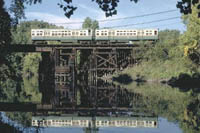 Cars 6043-6044, two of only 44 6000-series cars assigned to the line at the time, form a two-car southbound Ravenswood train crossing the North Branch of the Chicago River on the Ravenswood branch in October, 1965. The cars still wear the livery in which they were delivered 15 years earlier. For a larger view, click here. (Photo by Jerry Appleman) |
Car assignments on the branch continued to fluctuate for several years. In 1960s, the CTA's eight high-performance PCC test cars -- 6000-series cars 6127-6130 and 1-50 series 1-4 -- were put in regular-speed service on the Ravenswood route in their distinctive distinctive maroon and silver gray color scheme. Their presence was short-lived, with cars 1-4 reassigned in 1964 and by '67 only cars 6127-28 of the high-performance 6000s remained, which were finally reassigned in 1971. Although some flat-door 6000s were always assigned to the route during this period, the majority of service was provided by 4000-series cars -- baldies until about 1964-65, and plushies thereafter -- until 1971. In January, half of the 1-50 series fleet and some additional 6000s were assigned to the route, with enough PCC cars assigned by April 1971 to provide all base service. In September, the last 4000s were removed from the route. For the next decade or so, the branch was populated entirely by the St. Louis PCC equipment, with a collection of later-model 6000s joining the route in the mid-1970s.
The CTA made some small modernizations to the route beginning in the 1950s. In April 1954, automatic block signals were installed on the curve between Montrose and Damen stations in the Ravenswood neighborhood. This curve is somewhat sharp and views are obstructed by trees and surrounding homes; the signals provided for safer and faster operation on the branch.
The Rave Hits Troubled Times
As on many lines, the early- and mid-1970s saw a steady reduction in service and closure of stations and entrances as the CTA's financial problems reached critical mass and the agency needed quick and drastic ways to reduce costs. The year 1973, which saw an extensive series of closures and cutbacks across all lines, was particularly bad. First, in February, the CTA reduced agent coverage at several stations, particularly in the evening and on weekends. Then, in September, Paulina station was closed as an economy move due to its moderate ridership. Two days later, its neighbor to the north, Addison, became an A station to rebalance the skip-stop pattern. Paulina, however, was reopened just a month later on October 17, probably due to political pressure. It reopened as an A station, creating an odd stopping pattern of two such stations in a row, but perhaps as a compromise to the CTA's need for cost savings, it was only open Monday-Friday 0630-1830 hours only. The broadest service cut on the Ravenswood came in September 1976 when owl (late night) service was eliminated on the entire route.
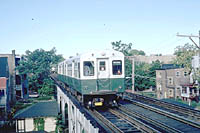 A 2-car train of 6000s makes a Ravenswood All-Stop run in September 1979. Another Rave train of 6000s is seen in the background. For a larger view, click here. (Collection of Joe Testagrose) |
In the late 1970s, the Ravenswood continued the mantle of a line of patchwork equipment assignments. The 6000-series assignments stabilized with service provided by the same flat-door 6000s that started out on the route, supplanted with "red-tagged" 6400-series units relegated to "belly car" service due to their lack of cab signals. The 1-50s were removed from the route, with the first 34 cars of the new 2400-series assigned to replace them. By late 1982, the 6400s were retired and by 1985 enough 2600-series cars had been delivered from Budd/Transit America that the 2400s were removed from the route and assigned entirely to West-South service, with some 2600s given to Ravenswood to supplement the 6000s. In Summer 1987, more 2600s were delivered and more 6000s were retired from the system, leaving the last of the 1950s PCC cars operating on the Ravenswood Line. A collection of 6000s and 2600s provided service for the next several years.
The 1980s saw some additional changes to Ravenswood service, some for better, others not. Work began in the late 1970s to rebuild Western station, the branch's largest in terms of ridership and an important intermodal transfer point. The station was a mishmash of facilities from different eras: the platforms dated from the original 1907 station, while the station house was rebuilt in the Gerber-designed Beaux Arts style in the 1920s. A bus transfer facility was added to the rear in 1949. So Western was included with four other stations on other lines in the CTA's modernization program circa 1980, including the first stations to receive accessibility with the installation of elevators. A temporary station house and center platform were opened at Western in 1979 during the duration of the station reconstruction. The new Western station complex opened in February 1981.
During 1980-81, the line's bridge over the North Branch of the Chicago River, between Rockwell and Francisco stations, was replaced. The bridge being replaced was a wooden trestle rather temporary in appearance but well over half a century old; its exact age is unclear. The old bridge was aligned on a "shoo-fly" -- a deviation in an otherwise straight path typically used to bypass around something -- and the track grading suggested that there had been a bridge there earlier which had probably burned by the early 1920s. Most likely, the shoo-fly was built around original bridge as a temporary measure while the old bridge was demolished and replaced, but replacement never came. In any case, by September 1981, the new bridge was in service and demolition had begun on the old wooden trestle.1
Not all of the changes were as positive, however. The same year that Western was completed, Monday through Saturday late evening Ravenswood shuttle service was truncated back on the North Side Main Line from the Loop to Belmont station, where riders could transfer to North-South trains. At that point, late night service was truly relegated only to the Ravenswood branch itself, with transfers to other rail service made at the first opportunity.
Paulina's status as a part-time station, only open Monday-Friday 0630-1830 hours, came to an end after 14 years when on November 2, 1987 trains began to stop on weekday evening to discharge passengers. Shortly thereafter, on November 29th, the station reopened for all hours that the Ravenswood Line was in service.
The 1990s brought new changes to the Ravenswood, ending some eras in the branch's life and beginning new chapters in other ways. One end came on the Rave, but represented a systemwide closure of an era: On December 14, 1992, the last 6000-series train made its regular in-service run on the Ravenswood. At the end of the day, the 6000-series cars were removed from passenger service, and while many remained in work service and several of their 1-50 series PCC brethren remained in use on the Evanston and Skokie lines for a year or so, the retirement of these cars represented the end of the road for a series of cars many generations of Chicagoans had come to know as the typical "L" car. But a new set of changes, representing a bright future for the Ravenswood, were on the horizon...
Ravenswood Goes Brown, Ridership Explodes
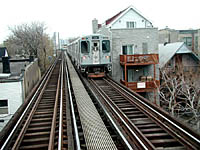 After the Brown Line leaves the North Side Main Line and continues onto the Ravenswood branch on its way to Kimball, single family and duplex detached houses begin to join the apartment buildings behind which the elevated structure snakes on its way northwest. Car 3216 brings up the rear of a Loop-bound Brown Line train near Seminary on April 18, 2003. For a larger view, click here. (Photo by Graham Garfield) |
The Brown Line also was to become to recipient of the system's newest railcars, the Morrison-Knudsen-built 3200-series units. 3200s began to enter Brown Line service in 1993 -- aside from testing of the prototype cars 3201-3204 on the Rave beginning in late February 1992 for a six-month testing program around the system -- and as of September 7, 1993 the 3200s provided all regular service on the route. The 3200-series cars were designed with full-width operating cabs for one-person train operation (OPTO), but for the time being conductors were retained on the line and operated from the rear cab of the last car of each train. This condition remained for just over a year until February 5, 1995, when conductors were eliminated on the line and the line went to one-man operation (with motormen becoming rapid transit "operators" or "RTOs"). Because the use of electronic fare media was still over two years away, and agent coverage was not provided at all times at most stations, onboard collectors were assigned to collect fares in place of conductors at off-peak times when agents were not assigned and pay-on-train operations were in effect. All 2600-series cars were eventually removed from the route, giving the Ravenswood two things it hadn't had in over 40 years: not only did it operate with all one type of equipment, but it was all the newest equipment on the system rather than a collection of hand-me-downs.
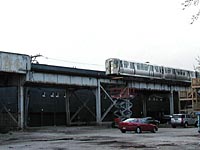 On March 30, 2003, a Brown Line train heads to downtown near Newport and Racine Avenues, passing the same spot workmen can be seen in the photo above constructing the elevated structure nearly a hundred years earlier. On the left is the beginning of a bridge for a long-gone railway -- the Milwaukee Road Evanston Division -- whose former right-of-way the "L" uses north of Wilson. For a larger view, click here. (Photo by Graham Garfield) |
This increase in population (which translated into increased ridership) began a steady improvement and restoration of service levels. On October 22, 1994, Saturday service was revised to run at 10 minute intervals and station agent coverage was added at several stations, including Rockwell and Paulina on the Ravenswood branch. On February 6, 1995, A/B skip-stop service was abandoned on the line, reduced to during rush hours only by the end, leaving all trains to make all stops at all times. In January 1996, weekday rush service was increased with one additional trip in both the morning and afternoon peak periods. After years of service reductions and a particularly severe year of cuts in 1997, the CTA began to build on their strengths and began with the well-performing Brown Line. In September 1998, a morning rush trip and three early afternoon rush trips were added and the schedule was modified so that six-car trains (the longest the Brown Line can run) operated all day from 5am to about 8pm. A couple months later, for the first time since 1981, the Brown Line began running downtown until midnight. "This is not about restoration of services, but rebuilding services for customers... to better match service to our needs and riding patterns," said CTA president Frank Kruesi at the time. Starting on December 21, 1998, weekday service on the Brown Line directly to the Loop was expanded with one additional run in the morning (leaving Kimball at 0445 hours) and eight evening trips added (the last leaving Merchandise Mart northbound at 0003 hours), continuing two hours later than the previous schedule.
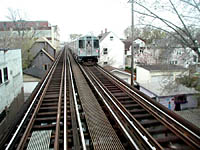 Where the Ravenswood branch parallels Ravenswood Avenue, the neighborhood is an eclectic mixture of low and medium-density residences and industrial buildings, as evidenced by the detached homes and industrial complex in the left background near Grace Avenue on April 18, 2003. For a larger view, click here. (Photo by Graham Garfield) |
Increased population has translated into increased ridership. According to the 2000 Census, the number of commuters in North Center who took public transit (or a taxi) to work was 29.1% and 31.1% took it in Lincoln Square. By 2001, the Brown Line carried approximately 104,000 riders on an average weekday. Ridership on the Brown Line increased by another 24% between 1997 and 2000. Now, the line's ridership has passed the 13 million/yard mark and continues to rise.
Brown Line Capacity Expansion Project
As a result of the increasing ridership, during peak hour periods the CTA is transporting crush-loads of customers on every car of the Brown Line. Crush-loads throughout peak travel times means sometimes trains are forced to leave commuters standing on platforms to wait, sometimes for one or two trains to pass them by before they are physically able to board a train to continue their trip at the stations close to the Loop. All Brown Line stations presently accommodate six-car trains -- with the exception of Merchandise Mart, Chicago, Fullerton and Belmont, which can hold eight-car trains -- but the Brown Line is one of only three CTA rail lines that cannot accommodate eight-car trains (the other two are the Purple and Yellow lines). Since the mid-1990s, CTA has made additional operational changes to accommodate demand on the Brown Line, including having Purple Line trains stop at Brown Line stations from Belmont to downtown Chicago. Despite these service adjustments, persistent crowding on Brown Line station platforms negatively affects the rail transit experience for passengers throughout the corridor.
The CTA decided that more six-car trains could not be added to handle the crowds, as the North Side Main Line is nearly at capacity with the present signal system and putting trains closer together might either compromise safety or reduce operating speeds. As a result, the CTA decided to plan for the Brown Line Capacity Expansion Project, a program that will become the largest capital improvement project undertaken by the CTA (surpassing even the Douglas Renovation Project, which was the largest up to that point). The main objectives of the Brown Line Capacity Expansion Project are to expand the line's overall ridership capacity by lengthening station platforms to accommodate eight rather than six-car trains, rehabilitate rail infrastructure and stations, provide for station enhancements to meet the accessibility requirements of the Americans with Disabilities Act (ADA), upgrade or replace traction power, signal and communication equipment, and reduce or eliminate slow zones.
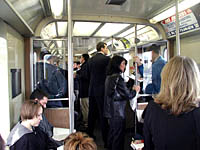 Because of the resurgence of popularity of many of the neighborhoods along the Brown Line, rush hour trains are standing room only. Some are crush-loaded, forcing trains to leave commuters standing on platforms to wait for another train. By the time of this view on the morning of April 25, 2003, rush hour was beginning to wane, but the passengers of car 2998 still had to stand in the aisles. For a larger view, click here. (Photo by Graham Garfield) |
While no one denies the benefits of running longer trains with more capacity -- especially the commuters who cram into those trains every day -- some members of the public were worried about the side effects of the project. Nearly 100 private parcels of land -- homes, restaurants, taverns and at least one church property -- stood in the way of the CTA's $540 million renovation of the Brown Line. For some, it was parts of backyards or entire homes or apartment buildings that were acquired, while for others it was businesses that were taken. The expanded platforms -- both longer for 8-car trains and wider for ADA compliance -- account for most of the air rights to be purchased from land owners. The elevators added at 16 stations will also took up some of the private property.
For preservationists, however, the arguments were somewhat different, though no less impassioned. The Landmarks Preservation Council of Illinois felt that the renovation may leave few of the quirky historical details that add to the character of the line. The CTA pointed out that it worked with state and federal preservation agencies on plans for the rehab. In the end, there were several preservation victories in the Brown Line designs along with some preservation loses.
On April 13, 2004, the CTA announced that it had officially received a Full Funding Grant Agreement (FFGA) from the Federal Transit Administration (FTA). Mayor Richard M. Daley, CTA President Frank Kruesi, Senator Richard Durbin, Congressman Rahm Emanuel, Governor Rod Blagojevich, and other officials announced the agreement allowing the Authority's project to rehabilitate 18 stations and expand capacity of the Brown Line to proceed at Ann Sather's Restaurant near the Belmont station.
Construction for the Brown Line Capacity Expansion Project was scheduled to begin in 2004, taking place on weekdays, evenings and weekends but with no station closures to complete projects as quickly but with as little disruption as possible. However, when the Brown Line project was advertised and bids for the construction portion were opened on May 5, 2004, the two responses that were submitted both exceeded the CTA's construction budget. The CTA has previously reported publicly that its total project budget, including items such as insurance, design, engineering and property acquisition, as well as construction, is $530 million. The bids the CTA received for the construction portion of the project were for $420.5 million and $541.2 million.
On June 9, 2004, the Chicago Transit Board voted to repackage and rebid construction work for the Brown Line Capacity Expansion Project. The CTA said the re-advertisement would not affect the project deadline, as the repackaging would allow for flexibility in the way work is scheduled. The project was reorganized into several discrete pieces to help attract more competitive construction bids. Signal system upgrades and electrical substation work formed one package. Work on station renovations were grouped into five separate packages according to location. The first package expected to go out for bid was Belmont/Fullerton. The other four packages were Armitage/Sedgwick/Chicago, Kimball/Kedzie/Francisco/Rockwell/Western, Damen/Montrose/Irving Park/Addison and Paulina/Southport/Wellington/Diversey .
At its monthly meeting on October 14, 2004, the Chicago Transit Board approved a $45.5 million construction contract for Aldridge - Mass, AJV (A Joint Venture) to upgrade the signal system. The state of the art signal system will provide the CTA and its customers greater service reliability and enhanced flexibility in service scheduling. Aldridge will rehabilitate the Brown Line's signal system from Kimball to Western, which involves installing signal equipment along the tracks, installing six new crossing gates and circuitry where the Brown Line crosses at street level at Spaulding, Kedzie, Albany, Sacramento, Francisco and Rockwell, and rehabilitating Kimball Tower from where signals control switches and direct trains. At Clark Junction, the location where Brown, Purple and Red Line tracks merge on the city's North Side just north of the Belmont station, the contractor will install a new signal system from Armitage to Addison, provide signals for 14 rail crossovers and rehabilitate Clark Tower located at the junction. Work began in fall 2004. Work at Clark Junction is expected to conclude late 2006 and signal and grade crossing work between Kimball and Western is expected to wrap up by summer 2007.
The station packages proved to be a bit trickier. In addition to the efficiencies hoped to be gained by bidding the stations as separate, grouped packages, $152 million worth of cost savings needed to be identified. The CTA reexamined their station designs and made many modifications, including the retention and refurbishment of many components, such as platform canopies, that were originally going to be completely replaced. Overall, the CTA focused largely on non-customer components such as communication rooms and janitor closets to further reduce the overall cost of construction. But another $22 million in construction costs still needed to be saved. This forced a difficult decision on the part of the CTA : to go back on their promise to keep stations open curing construction and propose temporary closures to allow work to proceed more quickly and give contractors the efficiency and economies of unobstructed access to the site.
Despite strong objections from many citizens and elected officials, the CTA announced on Friday, January 28, 2005 that in order to stay within the project budget and preserve amenities planned for neighborhood stations, the CTA will implement temporary closures of some Brown Line stations during construction. Under the plan, three stations &endash; Fullerton, Belmont and Western &endash; will remain open throughout construction. Maintaining service at these three heavily trafficked stations for the duration will minimize the effect of surrounding temporary station closures.
Armitage, Sedgwick and Chicago will remain open on weekdays. It will, however, be necessary to concurrently close all three of these southernmost Brown Line stations for up to six weekends during the construction period to allow construction crews unlimited access to station platforms. During these periods, customers will be encouraged to use the most convenient existing CTA bus and rail service in the area.
Damen, Montrose, Irving Park, Addison, Paulina, Southport, Wellington and Diversey will be subject to temporary weekday and weekend closures, with no adjacent stations being closed at the same time. Customers will be encouraged to use the next-closest or most conveniently located station during any given temporary closure.
Kimball, Kedzie, Francisco and Rockwell will be subject to two types of temporary closures. On weekdays and weekends, these stations will experience temporary closures, with no adjacent stations being closed at the same time. In addition, under the current plan, it will be necessary to concurrently close all four of these northernmost Brown Line stations for up to 10 weekends throughout the construction period to allow construction crews unlimited access to station platforms. During these periods, customers will be encouraged to use nearby existing CTA bus service.
The Brown Line station closings will begin after September 2005. The closings are aimed at minimizing the time to rebuild stations to make them accessible, lengthen platforms to accommodate longer trains, complete track work and modernize rail signals.
While many members of the public and elected officials said they understood the conundrum and would choose closures over lost amenities if forced into that choice, many were still critical of the decision, especially given the CTA's original promise to keep the stations open. Chairman Brown said that after an independent review, she decided that the temporary closings are necessary to stay within the project's $530 million budget and retain design amenities that include escalators, platform canopies and bicycle racks and said the "long-term benefits far outweigh the short-term inconvenience." Still, in a letter to the Federal Transit Administration outlining changes in the federally funded project's plan, Brown wrote: "CTA should have never promised such unaffordable station designs, and it should never have pledged to keep stations open."
The project's Full Funding Grant Agreement with the federal government requires that the CTA complete the project by the end of 2009. Separately, there is a 2008 deadline for accessibility work planned for the Fullerton station.
Only two years after the completion of the Brown Line Capacity Expansion Project, the wooden decking used at many stations began to deteriorate. Early evidence of the problem occurred at Francisco station, one of the first stations rebuilt in the project (making the planks there about six years old at the time the deterioration became noticeable). As of the end of August 2011, the CTA had spent $350,000 to replace and weather seal new boards at 14 stations, but the agency estimated it would have to spend about $175,000 more to completely replace the Francisco platform starting in September 2011.2 By the end of 2012, the total cost of replacing the wood decking at all of the affected Brown Line stations was $5.7 million.3
The problem occurred because the CTA changed materials for the project from the creosote-treated wood it had historically used to a wood product that included required fireproofing. The wood the contractors used included a fireproofing chemical on the wood that the CTA mistakenly believed would protect it against the elements as well.4
"The materials that were originally installed had a much shorter lifespan than they should have," said CTA spokesman Brian Steele. "They only lasted about five to six years. The materials that were installed, in moving forward, will have an expected lifespan of 15 to 20 years, and that's really what should be expected," Steele said. Asked by CBS Chicago whether the people responsible were held accountable, Steele said, "The staff that worked on that project are no longer with CTA. ... They've moved on to other employment. They retired."5
Thirteen stations total had their wood decking replaced, with the Diversey station the final Brown Line stop to have its platform replaced.6
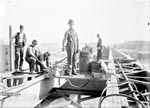 |
n004188.jpg
[off-site link] (84k) |
 |
cta16.jpg
(128k) |
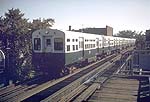 |
cta6070.jpg
(130k) |
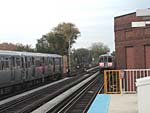 |
ROW@Lincoln01.jpg
(150k) |
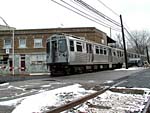 |
cta3455@Francisco.jpg
(213k) |
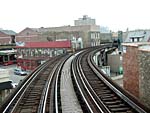 |
ROW@Sheffield01.jpg
(191k) |
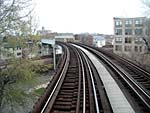 |
ROW@Ravenswood01.jpg
(211k) |
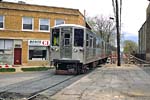 |
cta2319b.jpg
(147k) |
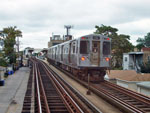 |
cta3222.jpg (173k) Car 3222 trails a 4-car Brown Line train on its way to the Loop, making it way up the ramp from the ground-level portion of the Ravenswood branch to the elevated segment, looking east in 2009. The train's next stop is Western station, visible in the distance. (Photo by Dennis Herbuth) |
|
|
1. Correspondence with Bruce Moffat, transit historian, March 13, 2014.
2.
Gerasole, Vince. "Wood Already Rotting At New CTA Brown Line Platforms." chicago.cbslocal.com, August 29, 2011. Accessed December 12, 2012.
3. "Cost To Repair Brown Line Rehab Mistakes Swells To $5.7M." chicago.cbslocal.com, December 11, 2012. Accessed December 12, 2012.
4. Ibid.
5. Ibid.
6. Ibid.